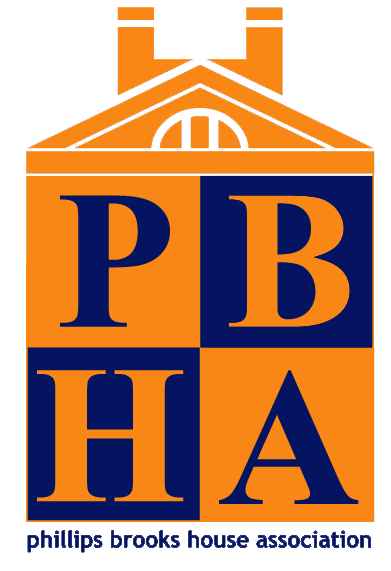Story #1: Phillips Brooks and the Legacy of Service
The Beauty of a Life of Service:
Phillips Brooks’ Legacy at the Phillips Brooks House Association
Mary Catherine Curley
At the northwest corner of Harvard Yard stands a brick building shadowed by oak trees, with three words emblazoned on its face: Piety, Charity, and Hospitality. The house was erected at the turn of the 20th century following Phillips Brooks’ death, a memorial effort funded and organized by his colleagues and friends.
Since 1904, the building has housed the Phillips Brooks House Association, a collective of student organizations devoted to public service. Student-run programs serving neighborhoods in Boston and Cambridge have provided adult, advocacy, after-school, housing, medical, mentoring, and summer services to thousands of people ever since. The building has been home to other social justice efforts over the years, including the university’s first women’s center and, mostly recently, programs housed through the Harvard Center for Public Service and Engaged Scholarship. By 1973, PBHA incorporated as a 501(c)(3) nonprofit. Today, it’s home to dozens of programs, including the Summer Urban Program, a neighborhood-based network of summer camps that enrolls 800 low-income children and provides summer employment to over a hundred local teens; the Harvard Square Homeless Shelter and Y2Y, two shelters which provide beds and hot meals to adults and young people experiencing homelessness, and English language classes for almost 600 adults. Not only is PBHA the largest student-run nonprofit in the country, it has run community-based programs in some Boston neighborhoods for decades – so long that a single family might have sent two generations to the same PBHA summer camp, or a former child participants in programming grow up to run the program they once attended.
Every day, students entering the house pass a bronze bust of Phillips Brooks, and a plaque that reads This House is dedicated to Piety Charity and Hospitality – in grateful memory of Phillips Brooks. Many are on their way to a community meeting, picking up a megaphone to take over to a protest, or making photocopies for the after-school program they’re running in Boston. Some are engaged in work that may define their lives, discovering a calling to work in education, housing, or organizing. Still others are facing questions of what kind of person they want to be and what kind of life they want to live, challenging each other’s notions of justice, equality, and solidarity. Years after graduation, PBHA alumni consistently name their in-depth service experiences as transformative. In the words of one 2003 alumnus, “I was really active in PBHA during a time in my life where I was figuring out the person I was going to be. The experiences and opportunities for reflection I had with PBHA made service part of my identity– for the rest of my life, I’ve asked myself whether what I’m doing makes the world better, and how. This is how I think of who I am.”
When the building was first built in Brooks’s name, he had passed away only seven years prior, and his friends and students felt strongly about what his legacy on the campus should be. Before his death, Brooks had joined other University Preachers in requesting a new building on Harvard’s campus specifically to house religious groups, to be “generously used for all the various public interests of university life, and should unite and strengthen many undertakings which now rather tend to divide the forces which make for good among the students.”1 His close friend Edwin Hale Abbott, who fundraised for the building following his death, emphasized Brooks’ wish “to stimulate spiritual life other than the intellectual work of these young fellows,” and urged classmates to help establish a building that might serve as “the very heart of the college, and the home of its religious and spiritual life in all those forms.”2 Later, at the building’s opening, Robert Treat Paine declared an even more ambitious vision for the house: that it might represent “the great elective of spiritual communion; to recognize as the fundamental fact of human existence that man is made in the image of God.”3
Over a century later, Phillips Brooks House both embodies and resists this vision, in fascinating and unexpected ways. The organization housed within the building has long declared itself officially secular, and students volunteering there might easily come and go without ever learning who the building was named for. As a former student and staff member at PBHA, this author was at first unsure what connections might be found between Phillips Brooks’ own reflections on service, the original vision for the house, and its current work. However, in his sermons to Harvard students–specifically, his final address in Appleton Chapel and his reflections on “the beauty of a life of service”–one can hear messages that resonate powerfully today with PBHA’s unique model of service learning and community action.
To read more about Phillips Brooks’ legacy at PBHA click HERE
_____________________________________
1 Gotlieb, H. (1963). The Friendship and the House: Phillips Brooks and Edwin Hale Abbot. Historical Magazine of the Protestant Episcopal Church, 32(1), pp.37–48.
2 Ibid.
3 Robert Treat, P. (1900). Phillips Brooks House. Address in Harvard Yard.
4 Ibid.
